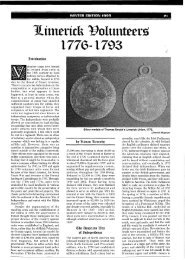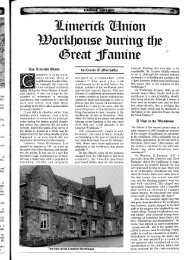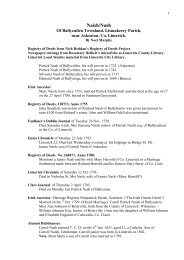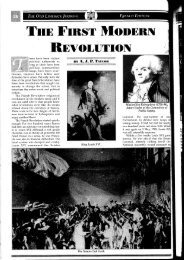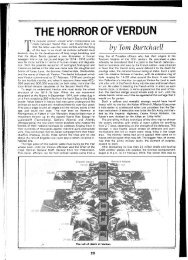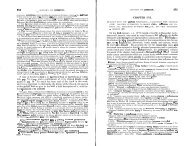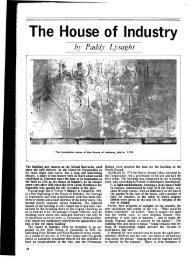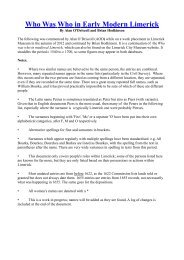The Limerick Distillery in 1886 by Richard Ahern (752 Kb)
The Limerick Distillery in 1886 by Richard Ahern (752 Kb)
The Limerick Distillery in 1886 by Richard Ahern (752 Kb)
Create successful ePaper yourself
Turn your PDF publications into a flip-book with our unique Google optimized e-Paper software.
Walker's Distille y, Thomondgate, with the manager's house on the far left of picture.<br />
DISTILLERY IN <strong>1886</strong><br />
he <strong>in</strong>vention of the art of<br />
distillation has been attributed<br />
to Arabian physicians.<br />
Other theories trace ~ts<br />
orig<strong>in</strong>s to Egypt, India and<br />
Ch<strong>in</strong>a, the Arabians be<strong>in</strong>g<br />
relegated to mere 'improvers' of the craft.<br />
It is difficult to give a precise year for the<br />
<strong>in</strong>troduction of the distillation of aqua<br />
vztae (water of life) to Europe, but the<br />
date is believed to co<strong>in</strong>cide with the<br />
commencement of the art <strong>in</strong> England,<br />
and is generally attributed to the period<br />
of Henry I1 (1133-1189). It is also thought<br />
that the skill was known <strong>in</strong> Ireland<br />
before the English acquired it. <strong>The</strong> name<br />
'whiskey' is derived from usquebaugh<br />
(uisce beatha), the Irish and Scottish<br />
Highland's Gaelic word which also<br />
means the water of life, and is a<br />
corruption of the Gaelic word uisce. <strong>The</strong><br />
word whiskey was co<strong>in</strong>ed towards the<br />
end of the 1770s, as it is not to be found<br />
<strong>in</strong> any record prior to that time.<br />
In <strong>1886</strong>, Alfred Barnard, a Londoner,<br />
came to <strong>Limerick</strong>. He was then a director,<br />
and subsequently took over the<br />
secretaryship, of Harper2 Weekly Gazette<br />
(later Harper's W<strong>in</strong>e and Spzrit Gazette).<br />
His visit was part of a mission throughout<br />
the United K<strong>in</strong>gdom, and he<br />
travelled extensively <strong>by</strong> road, rail and<br />
steamer. His <strong>in</strong>tention was to publish a<br />
description and history of the 28<br />
distilleries <strong>in</strong> Ireland, 129 <strong>in</strong> Scotland and<br />
4 <strong>in</strong> England, which he <strong>in</strong>spected. Dur<strong>in</strong>g<br />
his tour, he acquired a thorough knowledge<br />
of the <strong>in</strong>dustry, especially of the<br />
. .<br />
process, plants and production methods<br />
used <strong>in</strong> the operations.<br />
Barnard began his journey<strong>in</strong>gs with at<br />
least one advantage - he believed that<br />
good whiskey wa&the most wholesome<br />
spirit <strong>in</strong> the world. <strong>The</strong> distillers he<br />
visited responded equally positively to<br />
his <strong>in</strong>vestigations, and he was <strong>in</strong>variably<br />
met with courtesy and k<strong>in</strong>dness. He<br />
found that the pioneers of the trade were<br />
the smugglers of Ireland and Scotland<br />
and that their illicit methods formed the<br />
foundation on which the vast whiskey<br />
distill<strong>in</strong>g <strong>in</strong>terests had been established.<br />
Poteen-mak<strong>in</strong>g was a flourish<strong>in</strong>g bus<strong>in</strong>-<br />
ess <strong>in</strong> Ireland and, <strong>in</strong> 1806, over 25% of<br />
the entire whiskey production was<br />
estimated to have come from unlicensed<br />
stills. In the north and west of the<br />
country, where peat and water were<br />
plentiful, and poverty endemic, few<br />
<strong>in</strong>dustries gave as much employment,<br />
and none gave so much pleasure. Dur<strong>in</strong>g<br />
the years 1811 to 1813, no less than 19,067<br />
unauthorized stills were destroyed <strong>by</strong> the<br />
revenue and military. As many as 6,000<br />
illegal stilb were seized <strong>in</strong> 1820, when<br />
the flow of poteen was 3 to 4 times more<br />
than the output of 'parliament' whiskey.<br />
However, dur<strong>in</strong>g the n<strong>in</strong>eteenth century,<br />
the number of licenced distillers <strong>in</strong><br />
Ireland decl<strong>in</strong>ed swiftly - from 210 <strong>in</strong><br />
1798 to 23 <strong>in</strong> 1869. In Scotland and<br />
Ireland, the locations of illicit stills, <strong>in</strong><br />
caves, bothies, <strong>by</strong>res, rav<strong>in</strong>es and on<br />
bleak mounta<strong>in</strong>sides, often became the<br />
sites of the later licensed establishments<br />
which Barnard explored. He discovered,<br />
for example, that, of the Irish distilleries,<br />
at least Bushmills, <strong>in</strong> County Antrim, and<br />
two others at Bmsna, near Kilbeggan, on<br />
the borders of the K<strong>in</strong>g's County (Of- --<br />
and Westmeath, had smuggl<strong>in</strong>g orig<strong>in</strong>s.<br />
In 1823, there was a reduction <strong>in</strong> the<br />
duty payable on spirits, but from then<br />
on, throughout the rema<strong>in</strong>der of the '<br />
century, there was a gradual rise <strong>in</strong> the<br />
tax. Both Disraeli and Gladstone<br />
<strong>in</strong>creased the duty, the latter <strong>in</strong>stitut<strong>in</strong>g,<br />
from 1860, a uniform levy on home-made<br />
spirits <strong>in</strong> the three countries (Ireland,<br />
Scotland and England) at 10 shill<strong>in</strong>gs<br />
(50p) per proof gallon - the level at<br />
which it stood dur<strong>in</strong>g Barnard's tour. In<br />
<strong>1886</strong>, consumption <strong>in</strong> the three countries<br />
was as follows: Ireland, 4.9 millions;<br />
England 15.2 millions and Scotland 6.1<br />
millions, proof gallons. Ireland had<br />
shown a fall<strong>in</strong>g trend from 1840<br />
onwards, a decl<strong>in</strong>e attributed to the<br />
successful work of the temperance<br />
missions, but almost certa<strong>in</strong>ly also due to<br />
the effects of the Fam<strong>in</strong>e years, to a lack<br />
of gra<strong>in</strong> for mak<strong>in</strong>g whiskey, and to the<br />
decreas<strong>in</strong>g population.<br />
Despite the disappearance of- many<br />
Irish distilleries, which had shrunk to 28<br />
<strong>by</strong> this time, Irish whiskey began to enter<br />
<strong>in</strong>to competition <strong>in</strong> England with g<strong>in</strong>,<br />
rum and brandy. In the decade 1866-'75,<br />
it atta<strong>in</strong>ed considerable popularity there;<br />
dur<strong>in</strong>g the 1870s, it was be<strong>in</strong>g seriously<br />
challenged <strong>by</strong> Scotch, which was then<br />
becom<strong>in</strong>g a fashionable and popular<br />
dr<strong>in</strong>k. Forceful advertis<strong>in</strong>g and hard<br />
sell<strong>in</strong>g helped Scotch to <strong>in</strong>crease its hold<br />
on public taste <strong>in</strong> England, especially <strong>in</strong><br />
the London market. <strong>The</strong> English had to<br />
be persuaded to dr<strong>in</strong>k whiskey - but<br />
which would they choose? In the next<br />
decade, Irish whiskey fell from favour, as<br />
the follow<strong>in</strong>g figures show:<br />
Imports of spirits to England<br />
Year From Scotland, From Ireland<br />
proof gals. proof gals.<br />
1880 1.8 million 1.6 million<br />
1888 2.2 million 1.5 million<br />
Merchants had correctly foreseen that a
moderately-priced whiskey could be<br />
obta<strong>in</strong>ed from judicious blend<strong>in</strong>gs of<br />
malt and gra<strong>in</strong> spirit; <strong>in</strong> the case of<br />
certa<strong>in</strong> undist<strong>in</strong>guished whiskies, blend-<br />
<strong>in</strong>g made them palatable and profitable.<br />
James Buchanan had already devised his<br />
celebrated 'Black & White' blend, which<br />
became a dist<strong>in</strong>ctive brand name.<br />
By this time, Irish distillers were<br />
export<strong>in</strong>g to every land to which<br />
emigrants had found their way. After<br />
England, the United States was an<br />
expand<strong>in</strong>g market, but they did not<br />
overlook possibilities for new markets<br />
througho;t the Empire, especially <strong>in</strong><br />
India. <strong>The</strong>re had also been many changes<br />
<strong>in</strong> the work<strong>in</strong>g of the distilleries, which<br />
had, <strong>by</strong> then, grown <strong>in</strong>to a legalized and<br />
vast rev,enue-produc<strong>in</strong>g <strong>in</strong>dustry, and<br />
illegal distillation had been virtually<br />
stamped out. Under an able staff of<br />
revenue officers, the 'evil' had been<br />
almost entirely overcome, and the<br />
follow<strong>in</strong>g decennial statement shows the<br />
number of detections made over a fifty<br />
year period: a<br />
Year Ireland Scotland England Total<br />
1834 8,192 692 314 9,198<br />
1844 2,574 177 213 2,964<br />
1854 1,853 73 301 2,227<br />
1864 2,757 19 84 2,860<br />
1874 796 6 12 814<br />
1884 829 22 5 856<br />
<strong>The</strong>re was, however, a slight revival of<br />
illicit distill<strong>in</strong>g <strong>in</strong> the 1880s <strong>in</strong> both<br />
Ireland and Scotland. Its resurgence <strong>in</strong><br />
England was almost entirely connected<br />
with Irish immigrants, as were the<br />
shebeens of Glasgow. Tlfe Irish enthus-<br />
iasm for smuggl<strong>in</strong>g produced about<br />
Thomond Bridge, with the distille y <strong>in</strong> the background.<br />
1,000 detections a year <strong>in</strong> the 1880s,<br />
whereas <strong>in</strong> Scotland the number had<br />
fallen to about 20 annually.<br />
Alfred Barnard clearly derived much<br />
satisfaction and enjoyment from his<br />
journey<strong>in</strong>gs, although they were some-<br />
times long and wearisome, as when he<br />
travelled from Galway to <strong>Limerick</strong>.<br />
Hav<strong>in</strong>g concluded his <strong>in</strong>spection at Mr.<br />
Persse's distillery, Nun's Island, Galway,<br />
he set out for <strong>Limerick</strong>, and this was to<br />
be:<br />
one of the most tedious journeys we had<br />
experienced dur<strong>in</strong>g our lengthened stay<br />
<strong>in</strong> Ireland. <strong>The</strong> tra<strong>in</strong> proceeded for a<br />
greater part of the way at a snail's pace,<br />
through an un<strong>in</strong>terest<strong>in</strong>g track, and to<br />
make matters worse, the railway guard<br />
kept the tra<strong>in</strong> wait<strong>in</strong>g at several stations<br />
whilst he imparted the latest political<br />
news and local gossip to the<br />
stationmaster and his clerk.<br />
4<br />
Near<strong>in</strong>g his dest<strong>in</strong>ation, the scene<br />
changed and Barnard found himself<br />
travell<strong>in</strong>g rapidly through more pleasant<br />
countryside, along which the fast-<br />
flow<strong>in</strong>g waters of the Shannon swept on<br />
to the sea. Soon the spires of <strong>Limerick</strong><br />
came <strong>in</strong>to view, and, shortly afterwards,<br />
he reached the Great Southern & Western<br />
Railway Station at Nelson (now Parnell)<br />
Street. Here he found an 'omnibus' from<br />
the hotel wait<strong>in</strong>g for him. After d<strong>in</strong><strong>in</strong>g,<br />
he 'sauntered forth <strong>in</strong> the cool of the<br />
even<strong>in</strong>g to take stock' of his surround-<br />
<strong>in</strong>gs. He visited some well-filled<br />
churches <strong>in</strong> Newtown Pery, and then<br />
strolled along the riverside, before<br />
return<strong>in</strong>g to his hotel.<br />
On the follow<strong>in</strong>g morn<strong>in</strong>g, Barnard<br />
was driven to Archibald Walker's<br />
<strong>Distillery</strong> <strong>in</strong> Thomondgate, <strong>by</strong> way of<br />
Thomond Bridge. Over 70 people were<br />
employed there, many for-a good<br />
number of years. On his arrival, he was<br />
welcomed <strong>by</strong> the manager and con-<br />
ducted on a walk through the establish-<br />
ment. <strong>The</strong> works and build<strong>in</strong>gs covered<br />
more than 6 acres and were built, beside<br />
the Shannon. to a functional vlan. so as to<br />
1 .<br />
work largely <strong>by</strong> gravitation, and there<br />
was, naturally enough, an <strong>in</strong>exhaustible<br />
supply of water for every purpose. He<br />
commenced his <strong>in</strong>spection at the malt-<br />
<strong>in</strong>gs and barley-lofts, which formed a<br />
large build<strong>in</strong>g, 203 feet long and 103 feet<br />
wide, designed <strong>in</strong> the shape and appear-<br />
ance of an old baronial castle, hav<strong>in</strong>g two<br />
small, <strong>in</strong>ner courtyards, each of which<br />
was reached through a stone archway.<br />
<strong>The</strong> gra<strong>in</strong>-lofts, adjo<strong>in</strong><strong>in</strong>g the<br />
malt<strong>in</strong>gs, were 110 feet long and 90 feet<br />
wide, and were situated over a large<br />
bonded warehouse, where a powerful<br />
little eng<strong>in</strong>e hoisted the gra<strong>in</strong> to these<br />
floors atthe rate of ten baFrels a m<strong>in</strong>ute.<br />
<strong>The</strong> two malt<strong>in</strong>g-floors were connected<br />
with four kilns, two <strong>in</strong> the centre, and<br />
one at each end of the build<strong>in</strong>g; two were<br />
floored with perforated Worcester tiles,<br />
the others with wire cloth; and all of<br />
them were heated <strong>by</strong> open furnaces. <strong>The</strong><br />
malt<strong>in</strong>gs were connected with each other<br />
on both floors <strong>by</strong> two spacious galleries.<br />
On his way to the mill, Barnard<br />
passed through the brewhouse, which<br />
conta<strong>in</strong>ed the four large brew<strong>in</strong>g-tanks,<br />
--&qns-etc. <strong>The</strong> mill was a spacious, lofty<br />
bufid<strong>in</strong>g, divided <strong>in</strong>to two separate<br />
departments, one for the gr<strong>in</strong>d<strong>in</strong>g of<br />
gra<strong>in</strong>, and the other for malt; the former<br />
conta<strong>in</strong>ed four pairs of stones and the
latter two pairs. <strong>The</strong> eng<strong>in</strong>e used <strong>in</strong> the<br />
mill was one of 30 horse-power and,<br />
when necessary, could be connected with<br />
another of the same size, which drove the<br />
mach<strong>in</strong>ery of the distillery. In both mills,<br />
the grist (gra<strong>in</strong> for gr<strong>in</strong>d<strong>in</strong>g) and ground-<br />
malt was carried <strong>by</strong> a double set of<br />
elevators and hoppers.to the upper floors<br />
of the mill, then along a bridge <strong>in</strong>to the<br />
grist-loft over the mash-house. <strong>The</strong><br />
mash-house conta<strong>in</strong>ed two large mash-<br />
tuns, with stirr<strong>in</strong>g gear and dra<strong>in</strong><strong>in</strong>g-<br />
plates.<br />
He then <strong>in</strong>spected the coolers, which<br />
formed a part of the roof of the mash-<br />
house, and also the water-tanks, placed<br />
on the roofs of the adjo<strong>in</strong><strong>in</strong>g build<strong>in</strong>gs, at<br />
a higher altitude to the refrigerators. At<br />
the suggestion of his guide, he climbed<br />
on to a platform elevated over the tanks,<br />
where he had a splendid view of the<br />
Clare Hills, the counties of <strong>Limerick</strong> and<br />
Tipperary, the w<strong>in</strong>d<strong>in</strong>gs of the River<br />
Shannon, K<strong>in</strong>g John's Castle, then be<strong>in</strong>g<br />
used as a barracks, and K<strong>in</strong>g's Island, on<br />
the opposite side of the river, where a<br />
partyf cavalry were exercis<strong>in</strong>g that day.<br />
Return<strong>in</strong>g to the ma<strong>in</strong> build<strong>in</strong>g, he came<br />
to the cool<strong>in</strong>g-room, which conta<strong>in</strong>ed<br />
four refrigerators. He also checked the<br />
pump-room and the worm-tub of the<br />
wash stills, which conta<strong>in</strong>ed n<strong>in</strong>e copper<br />
coils.<br />
Alfred Barnard next <strong>in</strong>spected the<br />
fire-fight<strong>in</strong>g equipment. Six years before,<br />
a serious fire had broken out <strong>in</strong> one of<br />
the spirit-safes of the distillery, which<br />
<strong>in</strong>terrupted distill<strong>in</strong>g for a week and<br />
caused about £2,000 worth of damage.<br />
<strong>The</strong> <strong>Limerick</strong> Chronicle, <strong>in</strong> its edition of 31<br />
January, 1880, carried this colourful<br />
account of the fire and the successful<br />
efforts of the three city fire brigades to<br />
br<strong>in</strong>g it under control:<br />
On Thursday even<strong>in</strong>g, a few m<strong>in</strong>utes<br />
after six o'clock, a fire, which for a<br />
considerable time assumed an aspect of a<br />
most portentous character, broke out <strong>in</strong><br />
one of the spirit-safes of the <strong>Distillery</strong> of<br />
Messrs. Archibald Walker and Company,<br />
Thomondgate. <strong>The</strong> orig<strong>in</strong> of the fire was<br />
of the most accidental nature, and no<br />
blame whatsoever can be attached to any<br />
of the employees of the concern. It would<br />
appear that the non-condensed spirit-<br />
vapour suddenly ignited, the flame<br />
immediately spread<strong>in</strong>g to the various<br />
<strong>in</strong>flammable materials around. In a few<br />
m<strong>in</strong>utes the entire of that portion of the<br />
premises was <strong>in</strong> a sheet of flame, and as<br />
the burn<strong>in</strong>g build<strong>in</strong>g was <strong>in</strong> immediate<br />
contiguity with the extensive spirit<br />
vaults, and explosion for a time seemed to<br />
be almost imm<strong>in</strong>ent. Had this taken place<br />
the entire build<strong>in</strong>g must have been<br />
entirely destroyed. Upon the r<strong>in</strong>g<strong>in</strong>g of<br />
the <strong>Distillery</strong> alarm bell a large but<br />
extremely orderly crowd collected <strong>in</strong> the<br />
neighbourhood of the burn<strong>in</strong>g premises.<br />
Without loss of time messengers were<br />
dispat>hed to the several eng<strong>in</strong>e stations<br />
for assistance. At 7 o'clock the<br />
Corporation fire 2kg<strong>in</strong>e under Inspector<br />
Forrest with his men <strong>in</strong> full uniform<br />
Bar mirror advertis<strong>in</strong>g <strong>Limerick</strong> Distille y.<br />
'<strong>The</strong> whiskey made <strong>in</strong> this distillery is of good reputation and full-bodied<br />
and is said to possess rapidly matur<strong>in</strong>g qualities'.<br />
arrived upon the scene. Flve m<strong>in</strong>utes completely got under control, and <strong>by</strong><br />
subsequent to this, the Merchants' Fire eleven it was altogether ext<strong>in</strong>guished. TO<br />
Brigade came up <strong>in</strong> dash<strong>in</strong>g style, the<br />
eng<strong>in</strong>e be<strong>in</strong>g drawn <strong>by</strong> two f<strong>in</strong>e horses ...<br />
Accompany<strong>in</strong>g it were the full brigade of<br />
the Volunteers, compris<strong>in</strong>g eleven<br />
members, attired <strong>in</strong> brazen helmets, and<br />
appo<strong>in</strong>tments perfect. <strong>The</strong>ir admirable<br />
organisation elicited universal admiration<br />
from the assemblage ... It be<strong>in</strong>g ... the<br />
maiden essay of the brigade at an actual<br />
conflagration, speculation was rife as to<br />
say that the young gentlemen who<br />
composed the Merchants' Fire Brigade<br />
exhibited undoubted proofs, both of<br />
discipl<strong>in</strong>e and courage, would, <strong>in</strong>deed,<br />
convey but a partial encomium upon<br />
their services ... <strong>in</strong>deed, the admirable<br />
services rendered <strong>by</strong> the brigade, and to<br />
their magnificent eng<strong>in</strong>e, may be<br />
attributed the speedy ext<strong>in</strong>guish<strong>in</strong>g of the<br />
flames.<br />
the manner <strong>in</strong> which it would perform its<br />
devoir. <strong>The</strong> West of England engwhich<br />
for many years past has done such<br />
good work for the citizens, was the last to<br />
arrive on the scene ... About ten o'clock it<br />
became apparent that the fire had been<br />
Dur<strong>in</strong>g his visit, Barnard was impressed<br />
-- with the safety precautions. <strong>The</strong> firefight<strong>in</strong>g<br />
equipment was the most modern<br />
of its k<strong>in</strong>d - fire-cocks and hoses were<br />
distributed throughout the distillery and
'<strong>The</strong> manager then <strong>in</strong>vited Barnard to his house, a picturesque old mansion,<br />
immediately outside the plant on the ve y edge of the river'.<br />
ground-boxes with hydrants, were<br />
placed along the numerous courts, and<br />
all were connected with the watertanks<br />
on the top of the build<strong>in</strong>g. A fire-eng<strong>in</strong>e<br />
was also kept permanently on the<br />
premises.<br />
Cross<strong>in</strong>g the square, he next entered<br />
the still-house, an elevated structure<br />
which conta<strong>in</strong>ed three copper-pot stills.<br />
One of the stills was constructed <strong>in</strong> the<br />
previous year for the manufacture of real<br />
Irish whiskey, and was regarded as a<br />
model still, embrac<strong>in</strong>g every improve-<br />
ment which had suggested itself to its<br />
renowned builders, John Miller &<br />
Company of Dubl<strong>in</strong>.<br />
Cont<strong>in</strong>u<strong>in</strong>g his <strong>in</strong>spection, he went to<br />
the spirit store, wherehe saw the various<br />
appliances for cask<strong>in</strong>g and weigh<strong>in</strong>g the<br />
whiskey. <strong>The</strong>n, pass<strong>in</strong>g Archibald<br />
Walker's house, which was located<br />
with<strong>in</strong> the enclosed premises, he saw the<br />
four bonded stores, the excise offices,<br />
and the carpenters', eng<strong>in</strong>eers',<br />
coppersmiths' and brassfitters' shops.<br />
<strong>The</strong> manager then <strong>in</strong>vited Barnard to<br />
his house, a picturesque old mansion,<br />
immediately outside the plant on the very<br />
edge of the river. He was much impress-<br />
ed with the scene from the bay-w<strong>in</strong>dow,<br />
which 'commands a view that could not<br />
be surpassed from any house <strong>in</strong> Ireland;<br />
comprehend<strong>in</strong>g the city of <strong>Limerick</strong>, the<br />
river and shipp<strong>in</strong>g, K<strong>in</strong>g's Island - where<br />
the artillery and cavalry daily exercise,<br />
sail<strong>in</strong>g and fish<strong>in</strong>g-boats under the very<br />
w<strong>in</strong>dow, and many other pictures too<br />
numerous to mention'. After tast<strong>in</strong>g the<br />
'make', he visited the garden, luxuriant <strong>in</strong><br />
vegetables and flowers, and went from<br />
there to the extensive stables and<br />
cartsheds and, f<strong>in</strong>ally, to the cooperage.<br />
What was his verdict of the <strong>Limerick</strong><br />
whiskey? '<strong>The</strong> whiskey made <strong>in</strong> this<br />
distillery is of good reputation and full-<br />
bodied and is said to possess rapidly<br />
matur<strong>in</strong>g qualities. It is designated "Pot<br />
Still Real Irish Whiskey", and is sold all<br />
over the three k<strong>in</strong>gdoms, and the annual<br />
output is 300,000 gallons'.<br />
On leav<strong>in</strong>g the distillery, he<br />
completed his tour of the city before<br />
return<strong>in</strong>g to his hotel, hav<strong>in</strong>g arranged to<br />
start for Cork <strong>by</strong> tra<strong>in</strong>. Alfred Barnard<br />
enjoyed his rambles to over 160 distill-<br />
eries throughout the three countries, and<br />
he sampled the fare <strong>in</strong> each and every<br />
one of them. After his lengthy travels, he<br />
stated, with a great deal of delight, pride<br />
and some nostalgia, that he could not.<br />
'refra<strong>in</strong> from express<strong>in</strong>g the delight with1<br />
which I look back upon my visits and<br />
associations with the distillers ... my ,><br />
extremely pleasurable <strong>in</strong>tercourse witxr<br />
them ... a more agreeable and hospitable<br />
class does not exist. Everywhere I was<br />
received courteously, and <strong>in</strong> many places<br />
with k<strong>in</strong>dly hospitality'.<br />
Alfred Barnard's book <strong>The</strong> Whisky<br />
Distilleries of the United K<strong>in</strong>gdom, was<br />
published <strong>by</strong> Harper's Weekly Gazette <strong>in</strong><br />
the follow<strong>in</strong>g year (1887). <strong>The</strong> author, <strong>in</strong><br />
his preface, modestly claims that he has<br />
no practical knowledge of distill<strong>in</strong>g, or<br />
even any close connections with the<br />
<strong>in</strong>dustry, but it is clear, <strong>in</strong> the words of<br />
J.A. Glen, who wrote the <strong>in</strong>troduction to<br />
the 1969 edition of the book, that Barnard<br />
was a 'Londoner with a lively and<br />
<strong>in</strong>quisitive turn of m<strong>in</strong>d'. He was also a<br />
prolific writer and an <strong>in</strong>defatigable<br />
traveller and, <strong>in</strong> 1889-'91, wrote a<br />
monumental four-volume work, <strong>The</strong><br />
Noted Breweries of Great Brita<strong>in</strong> and Ireland.<br />
In 1895, another one of his books,<br />
Orchards and Gardens Ancient and Modern,<br />
was published. We are fortunate that he<br />
has left us a lively and detailed account<br />
of his visit to the <strong>Limerick</strong> <strong>Distillery</strong> <strong>in</strong><br />
<strong>1886</strong>.<br />
SOURCES<br />
1. <strong>The</strong> Whisky Distilleries of the United<br />
K<strong>in</strong>gdom <strong>by</strong> Alfred Barnard, HarperS<br />
Weekly Gazette, 1887.<br />
2. New Introduction <strong>by</strong> Miss J.A. Glen<br />
to the 1969 edition of Alfred<br />
Barnard's book, David & Charles<br />
Limited, Devon.<br />
3. Focldir Gaeilge - Biarla le Niall 0<br />
Dbnaill, 1977.<br />
4. Lewis's Atlas of the Counties of Ireland,<br />
1837.<br />
5. <strong>Limerick</strong> Chronicle, 29 January, 1880.<br />
6. Ibid, 31 January, 1880.<br />
'<strong>The</strong> works and build<strong>in</strong>gs covered more than 6 acres and were built beside the Shannon'.


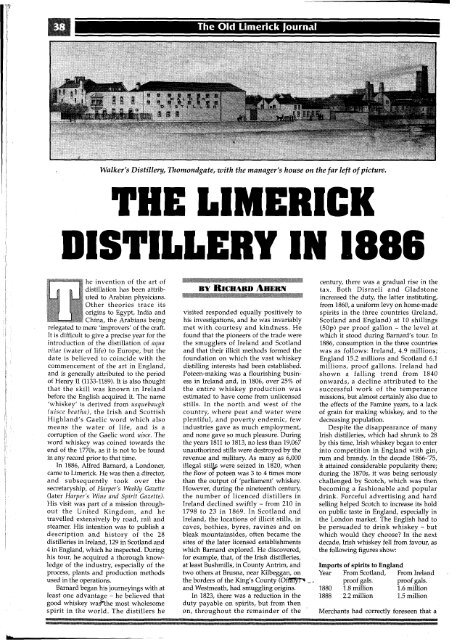
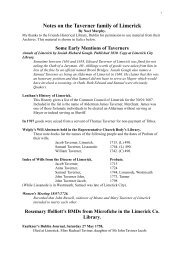

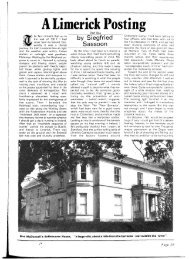
![The Galbally farmer [poem] by Darby Ryan - Limerick City Council](https://img.yumpu.com/24792577/1/190x260/the-galbally-farmer-poem-by-darby-ryan-limerick-city-council.jpg?quality=85)
